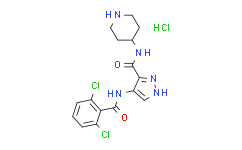| Cas No.: | 902135-91-5 |
| Chemical Name: | 4-(2,6-Dichlorobenzamido)-N-(piperidin-4-yl)-1H-pyrazole-3-carboxamide hydrochloride |
| Synonyms: | AT 7519;N-(4-Piperidinyl)-4-(2,6-dichlorobenzoylamino)-1H-pyrazole-3-carboxamide hydrochloride;AT 7519 Hydrochloride;4-(2,6-Dichlorobenzoylamino)-1H-pyrazole-3-carboxylic Acid Piperidin-4-ylamide Monohydrochloride;4-[(2,6-dichlorobenzoyl)amino]-N-piperidin-4-yl-1H-pyrazole-5-carboxamide,hydrochloride;AT-7519;AT7519 (Hydrochloride);AT-7519 (hydrochloride);AT7519 HCl;AT-7519 HCl;AT-7519(HCl);AT7519.HCl;N-(4-piperidinyl)-4-(2,6-dichlorobenzoylamino)-1H-pyrazole-3-carboxamide Hcl;AT-7519 Hydrochloride;AT-7519M;QCR-194;AT7519 Hydrochloride;4-(2,6-dichlorobenzamido)-N-(piperidin-4-yl)-1H-pyrazole-3-carboxamide hydrochloride;PubChem22417;AT7519(Hydrochloride);C16H17Cl2N5O2.HCl;AT7519(HCL);SYN1010;AOB2624;PAOFPNGYBWGKCO-UHFFFAOYSA-N;BCPP000382;BCP01950;s7808 |
| SMILES: | ClC1C([H])=C([H])C([H])=C(C=1C(N([H])C1C([H])=NN([H])C=1C(N([H])C1([H])C([H])([H])C([H])([H])N([H])C([H])([H])C1([H])[H])=O)=O)Cl.Cl[H] |
| Formula: | C16H18Cl3N5O2 |
| M.Wt: | 418.7054 |
| Sotrage: | 2 years -20°C Powder, 2 weeks 4°C in DMSO, 6 months -80°C in DMSO |
| Description: | AT7519 Hydrochloride is a potent inhibitor of CDKs, with IC50s of 210, 47, 100, 13, 170, and <10 nM for CDK1, CDK2, CDK4 to CDK6, and CDK9, respectively. |
| In Vivo: | AT7519 inhibits tumor growth in a human MM xenograft mouse model[1]. AT7519 (4.6 and 9.1 mg/kg/dose) inhibits the growth of early-stage HCT116 tumor xenografts. AT7519 (10 mg/kg, i.p.) also inhibits the target CDKs in HCT116 tumor-bearing BALB/c nude mice[2]. |
| In Vitro: | AT7519 (0-4 μM) results in dose-dependent cytotoxicity with IC50s ranging from 0.5 to 2 μM in MM cells, and this induced cytotoxicity is associated with GSK-3β activation independent of transcriptional inhibition. AT7519 overcomes proliferative advantage conferred by cytokines and the protective effect of BMSC. AT7519 (0.5 μM) induces apoptosis of MM cells in a time-dependent manner. Moreover, AT7519 (0.5 μM) inhibits phosphorylation of RNA polymerase II CTD and partially inhibits RNA synthesis in MM.1S cells[1]. AT7519 (250 nM) inhibits cell cycle progression in human tumor cell lines. AT7519 also induces apoptosis of human tumor cell lines[2]. AT7519 (100-700 nM) induces apoptosis in leukemia cell lines. AT7519 also inhibits transcription in human tumor cell lines. Furthermore, AT7519 inhibits RNA polymerase II and reduces antiapoptotic protein levels[3]. |






















